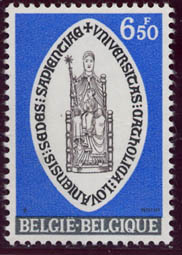The University of Louvain
Witness to War and Occupation
Credit: Courtesy of the Canadian Canon Law Society Newsletter, (Summer 2014, pp. 24-27, reprinted with permission)
August 2014 marks the centenary of a disaster which befell Belgium and its famous university in particular. At 8 o’clock on the morning of 4 August 1914, German forces crossed the border heading for France. In its southern path lay the ‘Oxford of Belgium’, the university town of Louvain which the army reached two weeks later amid unexpected Belgian resistance.
Seeing saboteurs even when they did not exist, German troops set fire to a large part of the city on 25 August and, in an uncharacteristic act of vandalism, deliberately burned the university library and all its holdings.
Following the war, the library was reconstructed in Flemish-Renaissance style and its collections were restored with donations from all around the world. In 1940, during the second German invasion of Louvain, the library was once again gravely damaged by fire although this time the blaze was thought to have started by an exchange of fire between the two armies, rather than a deliberate act. After the Second World War the library was again restored.
In a previous century, occupation destroyed more than the library when the region of Belgium was formally annexed by the revolutionary French republic. Under that government there was no autonomy as there had been under the Spanish and Austrian regimes and a government decree dated 25 October 1797 suppressed the old University of Louvain which had existed for more than 350 years.
On 9 December 1425 Pope Martin V replied to the request of the town of Louvain and of John IV, the Duke of Brabant, with the Bull Sapientiæ immarcescibilis which erected the first university in the Low Countries. From its very beginning until its suppression in 1797, it contained a facultas decretorum for instruction in canon law and a facultas legum for instruction in civil law, that is Roman Law.
After its suppression by the Directory, the University remained closed throughout the Napoleonic régime. When Belgium at last became a sovereign nation in 1830, her bishops took advantage of the provisions of its new Constitution on freedom of education and the separation of Church and State to re-establish the university.
With a joint letter of 14 November 1833, the bishops approached Pope Gregory XVI who assented to their request in a Brief dated 13 December of the same year which erected canonically The Catholic University of Louvain. This pontifical authorization to create a university was communicated to the country by an episcopal Decree of 10 June 1834. On the 4 November 1834 the university opened with three Faculties (Theology, Philosophy and Literature, and Science).
Although the university had the right to confer degrees in canon law, a separate faculty was not established. There was instead a special section for canon law in the faculty of theology. Only in 1935 did it become an autonomous faculty.
Marianus Verhoeven (1808-1850), who was effectively the first professor of canon law at the university, laid the foundation for the teaching of canon law at Louvain. In 1863 a chair was added in the relationship between Church and State, later entitled ‘Droit civil ecclésiastique’, which was first occupied by F.J. Moulart (1863-1904), who is famous for his influential work L’Église et l’État published in 1878 which marked an important evolution in the position of the Catholic Church on this subject.
Its most renowned professor was undoubtedly Alphonse van Hove (1872-1947) who began teaching there in 1904. In 1938 Willy Onclin (1905-1989) succeeded Van Hove as ordinary professor of canon law and went on to become adjunct secretary of the Papal Commission for the revision of the Code of Canon Law (1965-1983). Other distinguished graduates of the faculty included Arthur Vermeersch SJ (1858-1936) and his student and biographer Joseph Creusen SJ (1880-1960), who took over his master’s chair in moral theology in 1918 until 1938. Together they published the well-known commentary on the new Code: Epitome Iuris Canonici which first appeared in 1922-23.
From its beginning in 1834, the Catholic University of Louvain provided lectures only in French although Latin was used in the teaching of theology and canon law. Lectures in Dutch began to be provided in 1930 until 1968 when the Dutch-language section of the university became the independent Katholieke Universiteit Leuven, which remained in Louvain. The French-speaking university, called the Université catholique de Louvain, was moved to a campus called Louvain-la-Neuve farther south in the French-speaking part of the Province of Brabant. The split of the university brought problems once again for the library which was obliged to divide its holdings between the two new institutions.
After the university was split, the Faculté internationale de droit canonique of Louvain-la-Neuve lasted until 1983 when it became once again a section of the Faculty of Theology of the University. Its first dean was Henri Wagnon (1906-1983) and its last dean was Gérard Fransen (1915-1995) who had taught in the academic year 1947-1948 at the Université de Laval. While the licentiate or doctorate in canon law are not currently awarded at the Université catholique de Louvain, they continue to be granted by the Katholieke Universiteit Leuven whose Faculteit Kerkelijk Recht has also offered a complete English-speaking programme since 1988.
